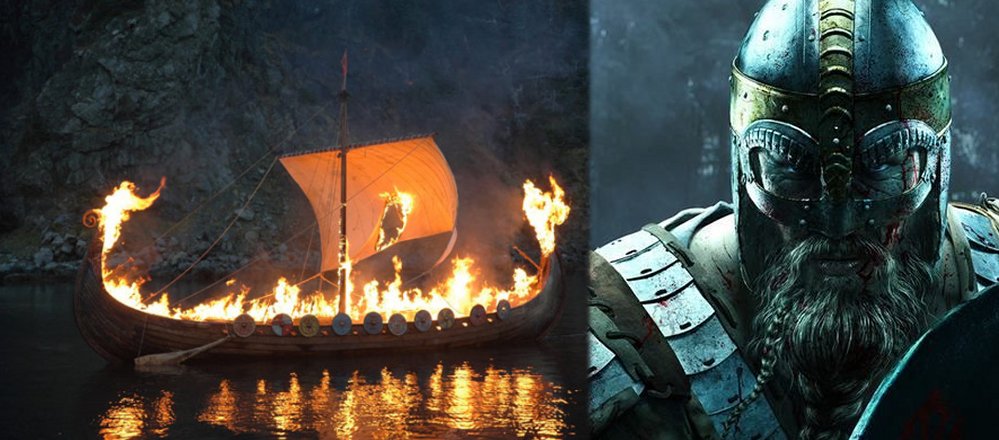Viking Burial Rituals: High Ancient Funeral Pyre Reflected High Social Status
Ellen Lloyd - AncientPages.com -Die as a true and brave warrior and you will go to Valhalla, the kingdom of the great Norse god Odin. That was the ultimate goal of every Viking. It was also the reason why warriors never feared, but rather embraced death
Fire played a central role in spectacular burial rituals practiced by the Vikings.
When a great Viking chieftain died, he received a ship burial. This involved placing the deceased on the ship, sailing him out to sea, and setting the Viking ship on fire. People could watch flames dance high in the air as they embraced the mighty warrior on his way to the afterlife.
By modern standards, it might sound crude, but Viking burials were intended to be a spectacular ritual. Viking funeral traditions involved burning ships and complex ancient rituals.
Ship Burial Was Reserved For Great Viking Warriors
Based on discovered archaeological evidence, it seems that the funeral boat or wagon was a practice reserved for the wealthy.
This type of burial was not common however, and was likely reserved for sea captains, noble Vikings, and the very wealthy. In Old Norse times, boats proper boats took several months to construct and would not have been wasted without a valid cause or a suitable amount of status.
Very few could receive a Viking ship burial. Image credit: Anne Burgess/Wikimedia
Another option was that the Viking was burned, and cremation was rather common during the early Viking Age. Ashes were later spread over the waters. The vast majority of the burial finds throughout the Viking world are cremations.
High Funeral Pyre Was A Symbol Of High Status
A high funeral pyre reflected high social status. By putting together, a wooden pyre, ten by twenty meters, reaching two meters up into the sky, one could be certain the blaze was burning bright.
Famous Vikings like Ragnar Lodbrok would receive a Viking ship burial.
“They used much more wood than was necessary—a few cubic meters would have been enough, but it was intended to be a spectacular ritual.
The number of symbolic gifts, such as beads, silver, and gold, increases with the size of the fire. The common denominator is that the dead is cremated, then you sift through the remains, and occasionally it was sealed with a mound,” says archaeologist Mogens Bo Henriksen from Odense City Museums.
Open Fire Was Used To Follow The Transformation And Say Farewell To The Deseaced
Henriksen’s research shows that special plants and woods were deliberately added to the fire to create smoke and smells. The cremation process was meant to activate all of our senses.
Vikings used open fire because people wanted to follow the transformation involved with the fire. It was an important part of the process of saying farewell to the dead.
Burial Rituals Took Place At Carefully Selected Locations
According to Henriksen, the pyres did not happen randomly or at random places. It was a carefully selected location.
It wasn’t about choosing the place where it was easiest to get firewood, but where the deceased should be buried,” he says.
The rituals were extensive and did not simply end with after the pyre had burnt down.
“There was more than burning going on here. Food was prepared, bone material was deposited in the ground, and animals and weapons were sacrificed as offerings. The graves are sealed and reopened. It wasn’t just a place where you burnt and buried people. The place represents the transition from the living to the dead. There’s a highly developed mindset behind these processes,” says Henriksen.
Henriksen has been excavating graves and the remains of pyres for the past three decades, leading to his cremation research. During this time, he discovered that ancient Viking tombs were dynamic.
I’ve looked at bones, urns, and gifts. But I began to think about the ritual itself. More and more, I think this was central,” says the archaeologist.
What we call a tomb today is a static thing or concept that represents a one-time treatment where the body is present in its entirety. But in ancient times, a tomb was a dynamic thing, says Henriksen.
“It could be opened, things could be placed there or taken out and closed again. A body could be split up,” he says. “We know that significant events took place after the cremation. The cremated remains are divided into portions, some are placed [in the tomb] while others are missing.”
Incredible Up Helly Aa Festival – Experience A Viking Ship Burial In Modern Times
During the Up Helly Aa festival in Lerwick, Shetland Islands, one can experience the sacrifice of a longship.
The annual festival began in 1870. It celebrates the influence of the Scandinavian Vikings in the Shetland Islands. The Norse ruled Shetland and neighboring island Orkney for about 500 years until they became part of Scotland in 1468.
Up Helly Aa is an incredible experience that cannot be easily forgotten. Several thousand people work the whole year to organize this fantastic event on the last Tuesday of January.
Written by Ellen Lloyd – AncientPages.com
Copyright © AncientPages.com All rights reserved. This material may not be published, broadcast, rewritten or redistributed in whole or part without the express written permission of AncientPages.com
More From Ancient Pages
-
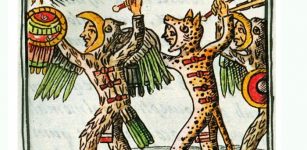 Florentine Codex: Remarkable Manuscripts About Life Of The Aztecs
Ancient History Facts | Nov 15, 2016
Florentine Codex: Remarkable Manuscripts About Life Of The Aztecs
Ancient History Facts | Nov 15, 2016 -
 On This Day In History: Parachute Jump From 1,000 m Above Paris Is Recorded – On Oct 22, 1797
News | Oct 22, 2016
On This Day In History: Parachute Jump From 1,000 m Above Paris Is Recorded – On Oct 22, 1797
News | Oct 22, 2016 -
 Massive Eruption Of Iceland’s Laki Volcano Triggered An Unusually Cold Winter In 1783-84
Archaeology | May 21, 2019
Massive Eruption Of Iceland’s Laki Volcano Triggered An Unusually Cold Winter In 1783-84
Archaeology | May 21, 2019 -
 Roman glass-making furnaces discovered in Egypt’s Delta
Civilizations | Aug 25, 2015
Roman glass-making furnaces discovered in Egypt’s Delta
Civilizations | Aug 25, 2015 -
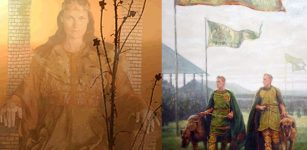 Tailteann Games: Ancient Irish Version Of The Olympic Games
Ancient History Facts | May 15, 2016
Tailteann Games: Ancient Irish Version Of The Olympic Games
Ancient History Facts | May 15, 2016 -
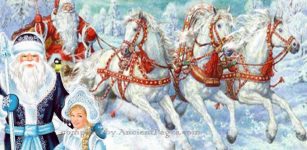 Grandfather Frost And Snow Maiden Bring Gifts On New Year’s Eve
Ancient Traditions And Customs | Dec 13, 2019
Grandfather Frost And Snow Maiden Bring Gifts On New Year’s Eve
Ancient Traditions And Customs | Dec 13, 2019 -
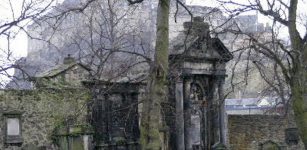 Mysterious Greyfriars Kirkyard: A Cemetery In Edinburgh With Dark And Spooky History
Featured Stories | Sep 16, 2016
Mysterious Greyfriars Kirkyard: A Cemetery In Edinburgh With Dark And Spooky History
Featured Stories | Sep 16, 2016 -
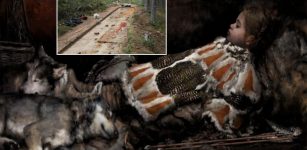 A Stone Age Child Buried With Bird Feathers, Plant Fibers And Fur Investigated In Finland
Archaeology | Nov 2, 2022
A Stone Age Child Buried With Bird Feathers, Plant Fibers And Fur Investigated In Finland
Archaeology | Nov 2, 2022 -
 Challenging Prehistoric Gender Roles – Women Were Hunters Too – Not Just Men
Archaeology | Oct 21, 2023
Challenging Prehistoric Gender Roles – Women Were Hunters Too – Not Just Men
Archaeology | Oct 21, 2023 -
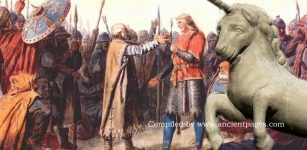 Vikings’ Unicorn Bluff Fooled Europeans For Hundreds Of Years
Ancient History Facts | Apr 24, 2018
Vikings’ Unicorn Bluff Fooled Europeans For Hundreds Of Years
Ancient History Facts | Apr 24, 2018 -
 ‘Impossible’ Ancient Knowledge Of The Gods’ Star – Mysterious Beings – Part 2
Featured Stories | Sep 4, 2021
‘Impossible’ Ancient Knowledge Of The Gods’ Star – Mysterious Beings – Part 2
Featured Stories | Sep 4, 2021 -
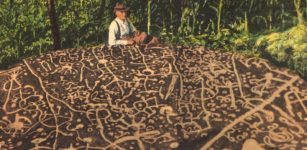 Mysterious Judaculla Rock And The Slant-Eyed Giant Of The Cherokee
Featured Stories | May 8, 2021
Mysterious Judaculla Rock And The Slant-Eyed Giant Of The Cherokee
Featured Stories | May 8, 2021 -
 Mysterious 70-Million-Year-Old Underground Village And Magnificent Tower Of Eben-Ezer In Belgium
Featured Stories | Mar 20, 2017
Mysterious 70-Million-Year-Old Underground Village And Magnificent Tower Of Eben-Ezer In Belgium
Featured Stories | Mar 20, 2017 -
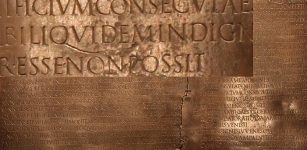 Roman Square Capitals: Prestigious Script That Delighted Human Eye With Its Elegance
Featured Stories | Sep 16, 2019
Roman Square Capitals: Prestigious Script That Delighted Human Eye With Its Elegance
Featured Stories | Sep 16, 2019 -
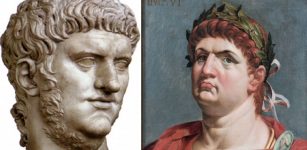 Who Was Pseudo-Nero?
Ancient History Facts | Apr 25, 2016
Who Was Pseudo-Nero?
Ancient History Facts | Apr 25, 2016 -
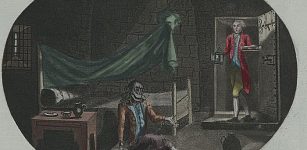 On This Day In History: “Man In The Iron Mask” Died In The Bastille, Paris, France – On Nov 19, 1703
News | Nov 19, 2016
On This Day In History: “Man In The Iron Mask” Died In The Bastille, Paris, France – On Nov 19, 1703
News | Nov 19, 2016 -
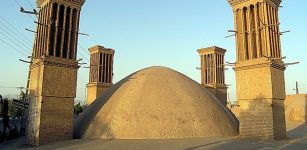 Remarkable Ancient Windcatchers: Air Conditioning Systems Built Since Antiquity
Ancient Technology | Sep 3, 2016
Remarkable Ancient Windcatchers: Air Conditioning Systems Built Since Antiquity
Ancient Technology | Sep 3, 2016 -
 Viking Longships: Fearless Dragonships Daring The Oceans And Seas
Ancient History Facts | Apr 16, 2016
Viking Longships: Fearless Dragonships Daring The Oceans And Seas
Ancient History Facts | Apr 16, 2016 -
 Last Of The Giant Camels And Archaic Humans Lived Together In Mongolia Until 27,000 Years Ago
Fossils | Mar 24, 2022
Last Of The Giant Camels And Archaic Humans Lived Together In Mongolia Until 27,000 Years Ago
Fossils | Mar 24, 2022 -
 Radar Discovery Of Ship-Shaped Anomaly Could Be Rare Viking Burial In Norway
Archaeology | Mar 26, 2019
Radar Discovery Of Ship-Shaped Anomaly Could Be Rare Viking Burial In Norway
Archaeology | Mar 26, 2019

